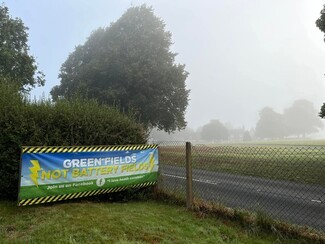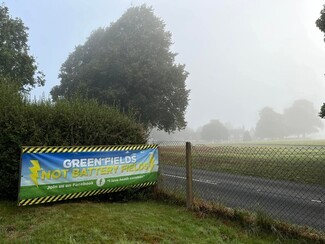Traveller site residents wait as fate of nearby controversial lithium-ion storage development hangs in balance

Wakefield Traveller site residents, who are part of a campaign to try to stop a local battery storage facility being built next to their homes, are waiting for a final decision by the government planning inspector on the fate of the controversial development.
Campaigners said the development by Harmony Energy could pose a fire risk to residents and harm the local conservation area.
More than 1,200 residents, along with MPs and councillors, objected to proposals to install 72 containers storing lithium-ion batteries on farmland.
BESS facilities take in power from renewable energy sources and then release it back to the National Grid when demand is high.
Wakefield Council initially rejected the planning proposal in July, however Harmony Energy appealed to the government planning inspectorate and an appeal inquiry is now set to take place on the 25th November.
Harmony Energy have released statements saying that their new battery farm at Heath Common is safe and there is nothing to worry about.

Anne-Marie Nicholson, chair of Wakefield and District Gypsy and Travellers’ Association, wrote to the Travellers Times on behalf of the Wakefield Traveller site residents:
It makes no sense why these battery farms are been sited practically in people's backyards villages on services stations courtyards and next to traveller sites … writes Annemarie Nicholson.
Simply put it’s not just a bad policy but a dangerous one and its literally playing with fire allowing this to happen.
We are taking about proposal to build a battery store system (BESS) large scale power storage site on Heath Common Wakefield.
These are lithium-ion batteries, batteries storage together in large metal shipping container size boxes 6ft apart, running behind the Travellers site in a long snake shape one after another in 2 lines all 66 boxes, with only the beck bordering them from the site a few feet away.
BESS technology is far from perfect the big issue which protesters the most are concerned about is the installation and potential vulnerability to fire . In the UK a fire at a BESS battery farm in Essex took 24 hours to extinguish.
And a similar fire at a site in Liverpool took 59 hours to put out .
Here in Wakefield our highways around the area are so busy most days getting emergency services through would be a nightmare. It would gridlock the entire city on hold. It could cost lives.
And residents on site would not be able to get out as some are disabled and would need extra support. Also, access is one way in and one way out and we have no fire hydrant on site as it is to fight fire until emergency service turned up.
The cause of such blazes is a process called thermal runway. Those can be triggered by events from short circuit to physically damaged to manufacture defects, and this can lead to release of flammable and toxic gases which then explode
Speaking to residents on Tuesday afternoon they said they are concerned about their horse’s welfare which many are grazing on the proposed land or nearby. They are also worried about the constant buzzing noise the battery farm could make and the effect it will have on the horses.
One resident was worried if it will affect their mental health with both the buzzing noise and the anxiety caused by wondering if it will catch fire
The children have said they will be frightened, and they are already frightened of the pylons which go through the site and the railway line which is nearby.

In 2022 journalist Katharine Quarmby published a damning investigation into how many Traveller sites were built near hazardous and/or polluted sites and facilities.
And even if Traveller sites are not initially built next to hazardous and polluting facilities – that can always be changed as the residents of Bedford Street Traveller site in Hull found out when the local council allowed a massive waste facility to be built right next to them in 2017.
TT News
(Images courtesy of Annemarie Nicholson and Heath Common campaign)